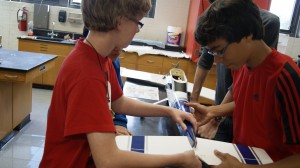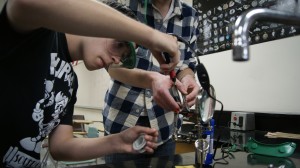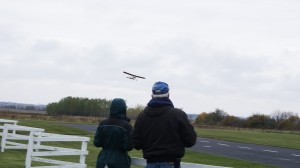
Robohub.org
Drones for Schools
To understand what the Drones for Schools program is, and how it came about, it helps to know a few things about my background. I didn’t originally set out to be a STEM educator. I had some science education from studying mechanical engineering as an undergraduate, but eventually wound up with a master’s in journalism. I didn’t think the two halves of my life would merge until I finished my master’s and took a job at a K-12 STEM education grant, at the University of Illinois – they needed someone with a scientific background to handle communications and study the social networks that teachers were forming as part of the grant.
At the time, I was researching how journalists could use aerial robots, commonly called “drones”, to capture data during natural and man-made disasters. As part of this research, I was spending a great deal of time in my basement “hacking” together a small drone from a radio controlled airplane and open-source hardware. It became apparent that this learning experience mirrored what teachers were doing in the STEM grant, and so I approached my boss, a department head in the College of Education one of the co-principal investigators for the grant, with a pitch: let’s have students design, build, and fly drones at our partner schools. He assembled a team of STEM educators to guide the process, and the “Drones for Schools” initiative was born.

Two students collaborate to build a “drone”.
In some ways, the program resembles a nesting doll for concepts in science, technology, engineering and mathematics. A drone is a complex machine, and once you peek inside, one STEM concept leads to another. To design the aircraft, you begin with concepts like Bernoulli’s principle, which when applied through a mathematical formula, determines parameters such as stall speed (how slow the plane can fly before falling out of the sky). Stall speed dictates the power you need to fly, which opens an opportunity to deliver content about electricity and electric motors. And delivering content about electricity and electric motors segues nicely into lessons about battery chemistry and capacity. All the while, students are applying this content knowledge as they make key decisions about how this aircraft will be designed and deployed.
Because this is a semi-autonomous aircraft that is dependent on a small microcontroller, computer programming is interwoven into the Drones for Schools curriculum. Students take this full-function microcontroller, which uses hackable open-source hardware and software, and learn programming by getting it to do some things it wasn’t intended to do. They learn about electronics prototyping by wiring up the microcontroller to external LEDs, and by writing C code to enabe the microcontroller to blink out a Morse code, they learn about variables, arguments, loops, functions, and libraries.

Soldering is one of the many skills that students learn through the Drones for Schools program.
These individual lessons are valuable on their own, but the program’s biggest gains come from students assuming the roles of engineers. This program was designed in part to meet the demands of the Next Generation Science Standards (NGSS), which were developed by the National Research Council to help prepare K-12 students for an world where science literacy is increasingly necessary. Perhaps one of the biggest challenges and opportunities presented by NGSS, is the incorporation of engineering education into the K-12 science curriculum, something which hasn’t been attempted on this scale. To help students understand what makes them engineers in the Drones for Schools program, and how that’s different from what scientists do, we’ve had a graduate engineering student explain how engineers make models, design solutions, and test those solutions. The engineering student also provided high school students with information on how their interests in the Drones for Schools program could lead to an education in engineering, and what an engineering career path looks like.
Drones for Schools is just one of around 30 collaborations at the National Science Foundation grant EnLiST, which stands for Entrepreneurial Leadership in STEM Teaching and learning. Each collaboration is unique, but they are all “entrepreneurial,” meaning they draw on resources from other classrooms, university faculty, community organizations, and businesses. Drones for Schools is no different than the other collaborations in the sense that we rely on community partners to provide a useful application for the drone. The drone is not built for the sake of building a drone; rather it is built because it can provide high-resolution images of the ground which can be stitched together in a map. And that data has use for farmers, city planners, researchers, first responders, and many others. Simply put, we think there is a need for drones in the community, and our students are trying to fill that need.

Testing out one of the class’ inventions
AUVSI, the Association for Unmanned Vehicles and Systems International, predicts that 30,000 drones will be flying by 2020, with the majority of those serving as farm equipment. Depending on the definition of a drone, the US may already have exceeded that number. The goal of this program isn’t to ensure that one of our students will engineer one of those drones someday, although technically they’re already building and flying one of those 30,000 when take part of our initiative. Rather, we’re interested in our classroom data, which suggests the initiative increases interest in engineering. And in that sense, I think we’ve succeeded.
UIUC faculty and staff associated with this grant are currently seeking other grants to specifically enrich middle school STEM education. Because of the tremendous learning opportunities packed into these flying robots (some of which are small enough to fly in a classroom), and because of their real-world importance, we believe that drones will be an integral part of STEM opportunities for some time.
tags: c-Education-DIY, cx-Aerial, education, Flying, interview, Mapping-Surveillance, Robohub focus on Robotics Education, Social aspect




